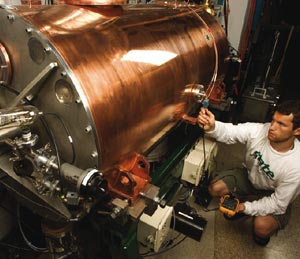Following a summer shutdown, the National Superconducting Cyclotron Laboratory (NSCL) at Michigan State University is looking ahead to new experiments with fast and reaccelerated beams.
The NSCL is a user facility and during the course of several years and hundreds of users, the list of experimenters’ requests became long enough to warrant a significant reconfiguration of the laboratory’s experimental area. The four-month long reconstruction project, which concluded successfully at the end of September, achieved a number of goals set by the users. These include a new capability to detect neutrons at larger angles to the beam axis and enhanced two-neutron detection; improved means for filtering proton-rich rare isotope beams and studying neutron-deficient nuclei; increased agility and flexibility in delivering beam to the experimental vaults; and performing an array of reaction studies, including precise measurement of neutron time-of-flight.

Image credit: NSCL.
The reconfiguration, which cost $2.7 million, was the largest construction project at NSCL since the completion of the Coupled Cyclotron Facility seven years ago. During the shutdown, more than 600 tonnes of concrete wall blocks were moved, as well as 1350 tonnes of roof beams. To speed up the rebuilding of the experimental vaults and to make it easier to change the layout of the facility in the future, NSCL installed 18 modular 22.5-tonne wall sections.
Following the reconfiguration, NSCL users now have access to a next-generation radio frequency separator, funded by the US National Science Foundation. The separator has performed well in early tests, for example, in selecting proton-rich isotopes near doubly magic 100Sn .
Laboratory upgrades will continue into 2008 and beyond. Current plans call for the implementation of two gas stoppers – a cyclotron gas stopper and a linear gas cell. The relative performance of each will be measured to determine the most efficient way to stop ions produced in flight and the best option for the NSCL reacceleration superconducting linear accelerator. This linac, being designed for use at NSCL and in a next-generation facility, will be able to reaccelerate thermalized beams of rare isotopes to energies of 3.2 MeV/nucleon with the option to upgrade it to 12 MeV/nucleon over the entire mass range.








